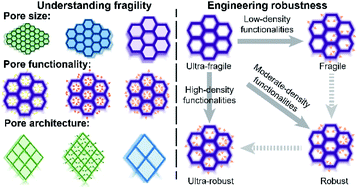Understanding fragility and engineering activation stability in two-dimensional covalent organic frameworks†
Abstract
The sensitivity of covalent organic frameworks (COFs) to pore collapse during activation processes is generally termed activation stability, and activation stability is important for achieving and maintaining COF crystallinity and porosity which are relevant to a variety of applications. However, current understanding of COF stability during activation is insufficient, and prior studies have focused primarily on thermal stability or on the activation stability of other porous materials, such as metal–organic frameworks (MOFs). In this work, we demonstrate and implement a versatile experimental approach to quantify activation stability of COFs and use this to establish a number of relationships between their pore size, the type of pore substituents, pore architecture, and structural robustness. Additionally, density functional theory calculations reveal the impact on both inter-and intra-layer interactions, which govern activation stability, and we demonstrate that activation stability can be systematically tuned using a multivariate synthesis approach involving mixtures of functionalized and unfunctionalized COF building blocks. Our findings provide novel fundamental insights into the activation stability of COFs and offer guidance for the design of more robust COFs.



 Please wait while we load your content...
Please wait while we load your content...